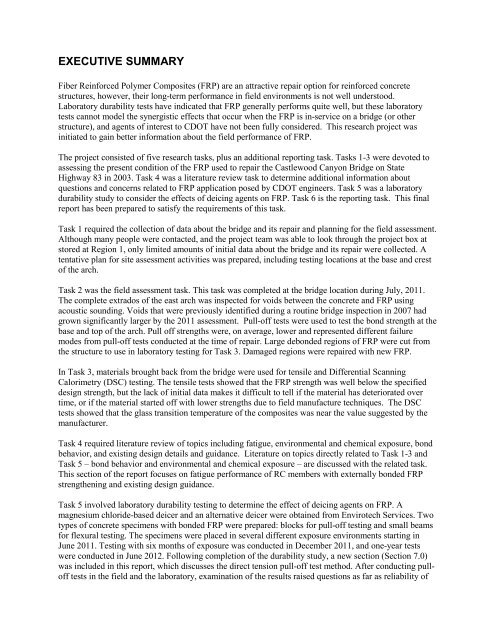Long Term Monitoring of Mechanical Properties of FRP Repair ...
Long Term Monitoring of Mechanical Properties of FRP Repair ...
Long Term Monitoring of Mechanical Properties of FRP Repair ...
You also want an ePaper? Increase the reach of your titles
YUMPU automatically turns print PDFs into web optimized ePapers that Google loves.
EXECUTIVE SUMMARY<br />
Fiber Reinforced Polymer Composites (<strong>FRP</strong>) are an attractive repair option for reinforced concrete<br />
structures, however, their long-term performance in field environments is not well understood.<br />
Laboratory durability tests have indicated that <strong>FRP</strong> generally performs quite well, but these laboratory<br />
tests cannot model the synergistic effects that occur when the <strong>FRP</strong> is in-service on a bridge (or other<br />
structure), and agents <strong>of</strong> interest to CDOT have not been fully considered. This research project was<br />
initiated to gain better information about the field performance <strong>of</strong> <strong>FRP</strong>.<br />
The project consisted <strong>of</strong> five research tasks, plus an additional reporting task. Tasks 1-3 were devoted to<br />
assessing the present condition <strong>of</strong> the <strong>FRP</strong> used to repair the Castlewood Canyon Bridge on State<br />
Highway 83 in 2003. Task 4 was a literature review task to determine additional information about<br />
questions and concerns related to <strong>FRP</strong> application posed by CDOT engineers. Task 5 was a laboratory<br />
durability study to consider the effects <strong>of</strong> deicing agents on <strong>FRP</strong>. Task 6 is the reporting task. This final<br />
report has been prepared to satisfy the requirements <strong>of</strong> this task.<br />
Task 1 required the collection <strong>of</strong> data about the bridge and its repair and planning for the field assessment.<br />
Although many people were contacted, and the project team was able to look through the project box at<br />
stored at Region 1, only limited amounts <strong>of</strong> initial data about the bridge and its repair were collected. A<br />
tentative plan for site assessment activities was prepared, including testing locations at the base and crest<br />
<strong>of</strong> the arch.<br />
Task 2 was the field assessment task. This task was completed at the bridge location during July, 2011.<br />
The complete extrados <strong>of</strong> the east arch was inspected for voids between the concrete and <strong>FRP</strong> using<br />
acoustic sounding. Voids that were previously identified during a routine bridge inspection in 2007 had<br />
grown significantly larger by the 2011 assessment. Pull-<strong>of</strong>f tests were used to test the bond strength at the<br />
base and top <strong>of</strong> the arch. Pull <strong>of</strong>f strengths were, on average, lower and represented different failure<br />
modes from pull-<strong>of</strong>f tests conducted at the time <strong>of</strong> repair. Large debonded regions <strong>of</strong> <strong>FRP</strong> were cut from<br />
the structure to use in laboratory testing for Task 3. Damaged regions were repaired with new <strong>FRP</strong>.<br />
In Task 3, materials brought back from the bridge were used for tensile and Differential Scanning<br />
Calorimetry (DSC) testing. The tensile tests showed that the <strong>FRP</strong> strength was well below the specified<br />
design strength, but the lack <strong>of</strong> initial data makes it difficult to tell if the material has deteriorated over<br />
time, or if the material started <strong>of</strong>f with lower strengths due to field manufacture techniques. The DSC<br />
tests showed that the glass transition temperature <strong>of</strong> the composites was near the value suggested by the<br />
manufacturer.<br />
Task 4 required literature review <strong>of</strong> topics including fatigue, environmental and chemical exposure, bond<br />
behavior, and existing design details and guidance. Literature on topics directly related to Task 1-3 and<br />
Task 5 – bond behavior and environmental and chemical exposure – are discussed with the related task.<br />
This section <strong>of</strong> the report focuses on fatigue performance <strong>of</strong> RC members with externally bonded <strong>FRP</strong><br />
strengthening and existing design guidance.<br />
Task 5 involved laboratory durability testing to determine the effect <strong>of</strong> deicing agents on <strong>FRP</strong>. A<br />
magnesium chloride-based deicer and an alternative deicer were obtained from Envirotech Services. Two<br />
types <strong>of</strong> concrete specimens with bonded <strong>FRP</strong> were prepared: blocks for pull-<strong>of</strong>f testing and small beams<br />
for flexural testing. The specimens were placed in several different exposure environments starting in<br />
June 2011. Testing with six months <strong>of</strong> exposure was conducted in December 2011, and one-year tests<br />
were conducted in June 2012. Following completion <strong>of</strong> the durability study, a new section (Section 7.0)<br />
was included in this report, which discusses the direct tension pull-<strong>of</strong>f test method. After conducting pull<strong>of</strong>f<br />
tests in the field and the laboratory, examination <strong>of</strong> the results raised questions as far as reliability <strong>of</strong>
















